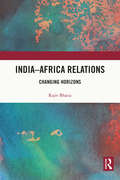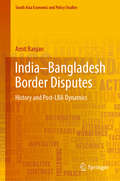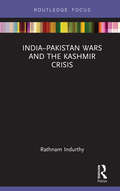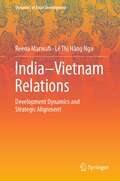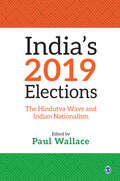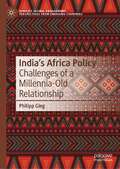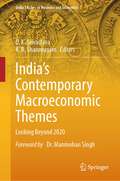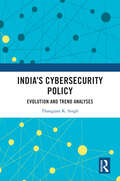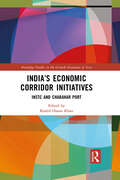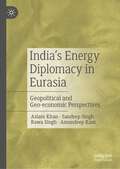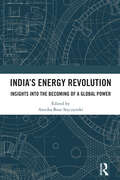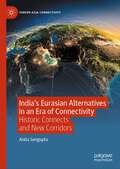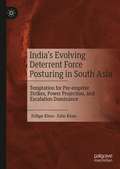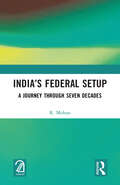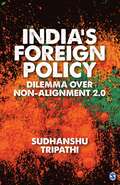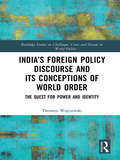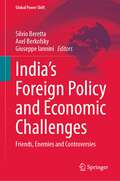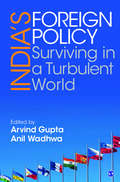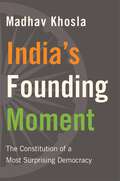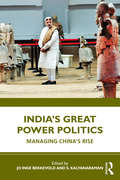- Table View
- List View
India–Africa Relations: Changing Horizons
by Rajiv BhatiaThis book explores the emergence and assertion of Africa as a significant actor and stakeholder in global affairs and the transformation of the India–Africa relationship. Beginning from this strategic perspective, the book presents an in-depth exploration of India–Africa partnership in all its critical dimensions. It delineates the historical backdrop and shared colonial past to focus on and contextualise the evolution of the India–Africa engagement in the first two decades of the 21st century. The book scrutinises the unfolding international competition in Africa in depth, which includes global actors such as the EU, US, and Japan, among others, focusing especially on China's growing influence in the region. Further, it dissects objectively the continental, regional and bilateral facets of India–Africa relations and offers a roadmap to strengthen and deepen the relationship in the coming decade. This volume will be very useful for students and researchers working in the field of international relations, foreign policy, governance, geopolitics, and diplomacy.
India–Bangladesh Border Disputes: History And Post-lba Dynamics (South Asia Economic and Policy Studies)
by Amit RanjanThis book discusses history of mental construction of the border between India and Bangladesh. It investigates how and when a border was constructed between the people, and discusses how the mental construction preceded the physical construction. It also examines the perils faced by those forced to leave their homes as a result of the partition of India in 1947. Globally throughout history, the absence of borders made the movement of people from one place to another easier. The construction of borders and sovereign de-limitation of territory restricted or even prevented seamless migration. The situation becomes more complex near borders that were previously open to the movement of people. One such border is between India and Bangladesh, where, in August 1947, suddenly people were told that the places they used to visit on a daily basis were now a part of a different sovereign country. This book argues that borders construct the identity of an individual or a group. Those who cross to the other side of border, for whatever reason, are identified and categorized by the state and the people. Sometimes these migrants face violence from the locals because they are considered a threat to the local working class. The book also explains how, after the liberation of Bangladesh in 1971, everyday encounter between people from India and Bangladesh have further embedded a feeling of us versus them. In 2015, India and Bangladesh agreed to implement the India–Bangladesh Land Border Agreement (LBA). This book assesses whether the implementation of this agreement will have impacts on border-related problems like mobility, migration, and tensions. It is a valuable resource for policymakers, journalists, researchers and students.
India–Pakistan Wars and the Kashmir Crisis
by Rathnam IndurthyThis book examines the origins of the conflict between two nuclear powers – India and Pakistan – and the instability and violence in the disputed territory of Kashmir. It presents to its readers a chronology of events and political decisions that have led to an intractable situation of the present, many decades since the stand-off between India and Pakistan started. Rathnam Indurthy traces the origins of the constant war-like situation between the two most powerful nuclear powers in South Asia through war and peace, agreements and talks, and political leaders and generals. From Indira Gandhi to Vajpayee, and from Zia-ul-Haq, Parvez Musharraf and Nawaz Sharif, the volume lays bare the various machinations on the political chessboard. It also looks at the internal issues and politics of Kashmir and offers explanations as well as solutions for the resolution of the festering impasse the two nations have reached. This volume will be of great interest to scholars and readers of foreign policy, international relations, South Asian politics, and defence and strategic studies.
India–Vietnam Relations: Development Dynamics and Strategic Alignment (Dynamics of Asian Development)
by Reena Marwah Lê Thị Hằng NgaThis book provides an in-depth analysis of the close cultural links between India and Vietnam. It discusses the issues of trade negotiations under the Regional Comprehensive Economic Partnership (RCEP) and the Indo-Pacific construct. Issues such as strengthening the economic partnership, contemporary development challenges posed by the COVID-19 pandemic, including weakening supply chains, and geo-strategic tensions are explored in this book. It enriches understanding of the potential of the two countries to develop as manufacturing hubs for the region and beyond. Given the more aggressive posturing by China in 2020, the concluding chapter includes the policy prescriptions with a futuristic vision, for India and Vietnam to catalyze their strategic and bilateral partnership. Well researched and analytical, the book draws extensively from several interviews of experts, diplomats, journalists, businesspersons, and members of the diaspora. It is a must read for students, researchers, think tanks, area study centers, and all institutions engaged in Asian studies, encompassing narratives extending from the developmental to political, from the bilateral to the multilateral and from the geo-economic to the geo-strategic.
India’s 2019 Elections: The Hindutva Wave and Indian Nationalism
This book, the sixth in the series on India’s elections from SAGE, is arguably the first to critically analyze the 17th General Elections held in India in 2019. It closely analyzes how the elections were conducted and what factors influenced the electorate in returning Narendra Modi to power with a thumping majority. The book critically explores underlying factors such as the absolute dominance of extreme nationalism based on majoritarian religious identity as well as the increased participation of women and the marginalized sections of Indian society. The initial chapters focus on national topics and are followed by fourteen analytical state and regional studies grouped into four regional clusters. A highlight of the book is its strong focus on contentious issues such as the structure, stability and integrity of electoral institutions as well as caste, tribal, minority and ethnic politics.
India’s Africa Policy: Challenges of a Millennia-Old Relationship (Africa's Global Engagement: Perspectives from Emerging Countries)
by Philipp GiegThe book analyses how India’s rise to the status of an emerging power has affected New Delhi’s Africa policy, after sketching the historical evolution and normative underpinnings of Indo-African relations, and what challenges it has brought for New Delhi’s engagement with the continent. India and Africa share a history dating back millennia. Today, India is one of Africa’s biggest trading partner countries, second only to China. The country regularly extends lines of credit worth billions to African nations, and its pharmaceutical producers dominate many African markets; almost one-fifth of India’s oil imports and more than one-quarter of its natural gas imports come from the continent. However, relations between India and Africa are far from being limited to economic cooperation. The book scrutinises three foreign policy fields: (1) India’s foreign economic policy towards Africa with an in-depth analysis of Indo-African trade, investment and lines of credit; (2) New Delhi’s development cooperation policy vis-à-vis Africa, its principles, instruments and volume; (3) India’s politico-diplomatic foreign and security policy vis-à-vis Africa, including New Delhi's high-level diplomacy, security and diaspora policy as well as multilateral Africa policy.
India’s Contemporary Macroeconomic Themes: Looking Beyond 2020 (India Studies in Business and Economics)
by D. K. Srivastava K. R. ShanmugamThis book extensively examines various contemporary macroeconomic themes of India, namely growth and macro policies, tax reforms, government finances and intergovernmental fiscal transfers, banking and monetary policy, and environment and social sector policies. It has three to six chapters devoted to each of these broad themes, with the contributors being eminent economists from the region. The book serves as an excellent reference for students in economics, finance, and management, and a valuable tool for professionals such as policymakers and investment analysts and other stakeholders in the areas of global economics and finance, in general, and India in particular.
India’s Cybersecurity Policy: Evolution and Trend Analyses
by Thangjam K. SinghThis book examines India’s public policies on cybersecurity and their evolution over the past few decades. It shows how threats and vulnerabilities in the domain have forced nation-states to introduce new policies to protect digital ecosystems. It charts the process of securitisation of cyberspace by the international system from the end of the 20th century to the present day. It also explores how the domain has become of strategic interest for many states and the international bodies which eventually developed norms and policies to secure the domain.Consequently, the book discusses the evolution of cybersecurity policy at global level by great powers, middle powers, and states of concern and compares them with the Indian context. It also highlights the requirement of introducing/improving new cybersecurity guidelines to efficiently deal with emerging technologies such as 5G, Artificial Intelligence (AI), Big Data (BD), Blockchain, Internet of Things (IoT), and cryptocurrency.The book will be of great interest to scholars and researchers of cybersecurity, public policy, politics, and South Asian studies.
India’s Defence Economy: Planning, Budgeting, Industry and Procurement
by Laxman Kumar BeheraAs the fourth largest military spender in the world, India has a huge defence economy supported by a budget amounting to nearly $67 billion in 2020–21. This book examines how well India’s defence economy is managed, through a detailed statistical exposition of five key themes – defence planning, expenditure, arms production, procurement and offsets. This book is based on hard-core evidence collected from multiple government and other credible sources including the ministries of Defence, Finance, and Commerce and Industry, Comptroller and Auditor General of India and the Reserve Bank of India. It discusses key issues such as the evolution of India’s defence plan; the feasibility of increasing defence spending; India’s defence acquisition system; and the recent reform measures taken under the rubric of the ‘Make in India’ initiative. Well supplemented with original tables and figures, India’s Defence Economy will be indispensable to students and researchers of defence and security studies, politics and international relations, finance, development studies, economics, strategic studies, South Asian politics, foreign policy and peace studies. It will also be of interest to defence ministry officials, senior armed forces personnel, military attachés, defence training institutes and strategic think tanks.
India’s Eastward Engagement: From Antiquity to Act East Policy
by Rahul Mishra S.D. MuniIndia’s Eastward Engagement: From Antiquity to Act East Policy presents India’s engagement with its extended eastern neighbours from ancient times to the present. It argues that this engagement has been long rooted in India’s geographical location, its civilizational evolution and historical transformations. The book critically examines all the important phases—Nehru and Post-Nehru periods, and Look East and Act East policies. It exposes the widely entertained myths about India’s eastward engagement and also underlines the prospective directions in which the Act East Policy may unfold in the years to come.
India’s Economic Corridor Initiatives: INSTC and Chabahar Port (Routledge Studies in the Growth Economies of Asia)
by Kashif Hasan KhanIndia’s Economic Corridor Initiatives highlights key aspects of current discourses on India’s initiative of the International North-South Transport Corridor (INSTC) and Chabahar, and their geo-economic significance.INSTC was founded by India, Russia, and Iran, and the Chabahar port in Iran provides a major prospective conduit for India's interchange and commerce with West Central Asia while maintaining a strategic distance from Pakistan's entry route. This book analyses the drastic changes in the equation of international relations in general, and more particularly between India and Eurasian countries. Contributors from Iran, Central Asia, Russia, Armenia and Europe provide a wide spectrum of opinion and analysis on the subject. The chapters claim that these corridors provide an alternative to the BRI and can play a pivotal role in de-escalating tensions through negotiations.A new addition to the debate on contemporary dynamics in Eurasia and India, this book will be of interest to researchers studying economic corridors, transnational and trans-regional economic relationships, security studies, regional and area studies, international relations and Indo-Iran-Russia relations.
India’s Energy Diplomacy in Eurasia: Geopolitical and Geo-economic Perspectives
by Sandeep Singh Amandeep Kaur Bawa Singh Aslam KhanThis book provides an accurate evaluation of re-integration of Eurasia in the context of India’s energy security and diplomacy which requires a normative shift as in the current Eurasian geopolitical and geo-economic matrix, the growing role of transit countries and their proximity with the Energy Complex Zone negates the fact that great powers or strong states control the Eurasian Heartland. Authors believe that wrecking this norm is fundamental here to deconstruct the undercurrents of energy geopolitics prevailing in Eurasia over the emerging phenomenon, as it discourages the re-integration of the Eurasian region. It explores how the geopolitical struggle between major powers for energy resources has been engendering mutual interdependencies between energy producers and transit countries. It makes an attempt to provide a transcontinental study of Eurasian energy and connectivity as a thrust area for the present work positioning Eurasia in Indian foreign policy, determining the contours of energy diplomacy in connection with the Eurasian energy policy. It defines Eurasia broadly as the region that encompasses Central Asia and the Caucasus including Russia and transit countries. It addresses the geopolitical and geo-economic aspects of Eurasian re-integration in the context of India’s energy security. The objective of this book is to combine theoretical, contemporary, and policy-oriented issues that deserve scholarly attention and would both complement and supplement the academic contributions.
India’s Energy Revolution: Insights into the Becoming of a Global Power
by Annika Bose StyczynskiIndia is the third-largest emitter of greenhouse gases, which makes it an important player whose climate mitigation actions and inactions are closely scrutinised. This book studies developments in India’s energy system from a governance perspective. It presents a unique compilation and synthesis of research findings that capture achievements, shortcomings, and persistent and transient challenges of India’s transition towards a net-zero economy by 2070.The book grounds its analysis in domestically formulated goals and reflects on dynamics at the structural level of India’s multi-scalar innovation system, by highlighting the influencing factors of energy system status and change. It presents the perspectives and positions of different actor groups, studies the market and business, and discusses cases influenced by existing or changing institutions across the whole spectrum of energy resources from fossil to non-fossil fuels and respective technologies.The volume will be useful for students and researchers in energy governance, energy policy and economics, socio-technical transition studies, energy systems engineering, sustainable development, and environmental studies. It will also be of interest to policymakers and investors.
India’s Eurasian Alternatives in an Era of Connectivity: Historic Connects and New Corridors (Europe-Asia Connectivity)
by Anita SenguptaThe volume examines how in the twenty-first century narratives built around connectivity have become a structural component of international politics expanding into a wider array of policy fields i It examines the significance of this emerging narrative from an Indian perspective with particular reference to Eurasian alternatives. It argues that this represents the next stage of globalization and that an understanding of this is increasingly becoming crucial given the recent disruptions along with the emergence of a spate of new policies and institutions that could eventually lead to a new understanding of connectivity.
India’s Evolving Deterrent Force Posturing in South Asia: Temptation for Pre-emptive Strikes, Power Projection, and Escalation Dominance
by Zafar Khan Zulfqar KhanThe book discusses India’s evolving deterrent force posturing in South Asia under the conceptual essentials of nuclear revolution when it comes to various combinations of conventional and nuclear forces development and the strategic implications it intentionally or unintentionally poses for the South Asian region. The book talks about how the contemporary restructuring of India’s deterrent force posture affects India’s nuclear strategy, in general, and how this in turn could affect the policies of its adversaries: China and Pakistan, in particular.Authors discuss the motivations of such posturing that broadly covers India’s restructuring of its Nuclear Draft Doctrine (DND), the ballistic missile development program, including that of its Ballistic Missile Defence (BMD) system, and the possibility of conflicts between China-India and India-Pakistan, given their transforming strategic force postures and their recurring adversarial behavior against each other in the Southern Asian region.
India’s Federal Setup: A Journey Through Seven Decades
by R. MohanThis book analyzes the evolution of our polity in the last seven decades by examining the developments in the economy, political events, and changing judicial perceptions. With a focus on the pertinent constitutional, political, economic, and social questions, it presents an overview of events which have influenced the evolution of federal and unitary tendencies.The subject matter of this book also discusses the emergence of coalition governments, dominance of a single party, relationships between the different tiers of the government, fiscal and economic issues, and political actions of constitutional authorities.Print edition not for sale in South Asia (India, Sri Lanka, Nepal, Bangladesh, Pakistan or Bhutan)
India’s Foreign Policy Dilemma over Non-Alignment 2.0
by Sudhanshu TripathiIndia’s Foreign Policy Dilemma over Non-Alignment 2.0 presents the story of India’s quest for renewed focus on the doctrine of Non-Alignment. It begins with a discussion on the evolution of India’s Foreign Policy along with the origin of its most important pillar, Non-Alignment, and its cumulative effect in India and abroad. It further discusses challenges, compulsions and constraints for India’s Foreign Policy in context of the current instability and insecurity due to mounting Chinese and Pakistani collusion against India’s rising profile in Asia, the emerging Pyongyang–Beijing–Moscow axis against the US, the evolving US–China bipolar world order in the background of eastward shifting geopolitics, economic recession and terrorism. The book argues that it is incumbent upon India to take a fresh lead today to reinvent the doctrine not only for its own national interests but also for the entire Third World. It proposes various steps to revitalize India’s Foreign Policy so that India can play a desired role in the present global order.
India’s Foreign Policy Discourse and its Conceptions of World Order: The Quest for Power and Identity (Routledge Studies on Challenges, Crises and Dissent in World Politics)
by Thorsten WojczewskiGiven India’s growing power and aspirations in world politics, there has been increasing interest among practitioners and scholars of international relations (IR) in how India views the world. This book offers the first systematic investigation of the world order models in India’s foreign policy discourse. By examining how the signifier ‘world order’ is endowed with meaning in the discourse, it moves beyond Western-centric IR and sheds light on how a state located outside the Western ‘core’ conceptualizes world order. Drawing on poststructuralism and discourse theory, the book proposes a novel analytical framework for studying foreign policy discourses and understanding the changes and continuities in India’s post-cold war foreign policy. It shows that foreign policy and world order have been crucial sites for the (re)production of India’s identity by drawing a political frontier between the Self and a set of Others and placing India into a system of differences that constitutes ‘what India is’. This text will be of key interest to scholars and students of Indian foreign policy, foreign policy analysis, South Asian studies, IR and IR theory, international political thought and global order studies.
India’s Foreign Policy and Economic Challenges: Friends, Enemies and Controversies (Global Power Shift)
by Silvio Beretta Axel Berkofsky Giuseppe IanniniThis book provides a state-of-the-art analysis of India’s foreign and security policies, examining e.g. the country’s security, economic and trade ties and interactions with Pakistan, China, the United States, Japan, the Middle East and ASEAN. Furthermore, the contributors provide the reader with an overview and analysis of the quality and challenges of India’s regional and global trade and investment policies. While in the past India has been a reluctant and not particularly prominent foreign and security policy actor in East and Southeast Asia as well as globally, China’s resurgence and its assertive and increasingly aggressive regional security policies have led India’s policymakers to reconsider the country’s decades-old non-alignment policies and opt for expanding security and defence ties with the United States, Japan and others. The Indian-Chinese border clashes in 2020 and China’s unlawful occupation of disputed territories along the Indian-Chinese border in the Himalayas have convinced Delhi’s policymakers and the country’s security and defence elites that India is well advised to join and contribute to US-led China containment policies. The expansion of India’s security and defence ties with Japan over recent years in particular will continue to be instrumental to keeping Beijing’s territorial expansionism in Southeast and South Asia in check. This volume analyses India’s involvement and engagement in regional and global trade and investment structures and flows in great detail. Written by a team of prolific European and Indian scholars, the book will be of interest to researchers in the fields of international relations and security studies, as well as policymakers at governmental or international organizations.
India’s Foreign Policy and Regional Multilateralism
by Arndt MichaelThe book provides a novel analytical perspective on regional multilateralism in South Asia and its neighbouring regions and covers the genesis, evolution and status quo of the four major regional organizations.
India’s Foreign Policy: Surviving in a Turbulent World
by Arvind Gupta Anil WadhwaWritten by foreign policy experts, academics and practioners, this book develops the frameworks and strategies for India’s foreign policy that can be adopted to meet the emerging challenges and non-traditional threats in the new world order. It studies the important aspects of India’s foreign policy in the present unsettled world order and comes up with strategies and policy suggestions. It raises several questions to highlight the future direction of foreign policy and the challenges that India may have to deal with in the coming years. The book covers the domestic dimension of the country’s foreign policy, which is often missed out in policy discussion. It examines the close link between national security and foreign policy, and shows how foreign policy can be leveraged to strengthen the economy and make India a hub of innovation. This book emphasizes soft power strategies to ensure that a strategic approach to soft power projection is adopted. India’s Foreign Policy: Surviving in a Turbulent World is a ready reference on India’s foreign policy that can be used to understand the complexities of the topics covered.
India’s Founding Moment: The Constitution of a Most Surprising Democracy
by Madhav KhoslaMadhav Khosla describes the remarkable work of the founders of independent India. All at once they built a democratic system in the midst of illiteracy and poverty enforced by a century of imperial domination and neglect. They crafted a constitution aimed at creating democratic citizens through democratic politics.
India’s Grand Strategy and Foreign Policy: Strategic Pluralism and Subcultures (Routledge Advances in South Asian Studies #39)
by Bernhard Beitelmair-BeriniThe book explores the competing grand strategic worldviews shaping India’s foreign and security policies by analyzing the interaction between normative modern international relations theories and vernacular concepts of statecraft and strategy. To assess the diverse competing ideas which characterize India’s debates on grand strategy and foreign policy, the author presents the subculture-cleavage model of grand strategic thought. This innovative analytical framework reveals the complexities of India’s strategic pluralism and offers the building blocks for a systematic analysis of grand strategy formation. The book demonstrates that the strategic paradigms, or strategic subcultures, are marked by contending ideas of Indian statehood and civilization, held by policymakers and the informed public, and are a result of ideology-driven perceptions of the country’s strategic environment. The author argues that the apparent hybridization and stretching of modern and traditional concepts of international relations in India has become a widespread feature of Indian foreign policy to meet the needs of state formation and nation-building. A unique approach to organizing and understanding the debates and discourse in Indian strategic thinking, the book will be of interest to specialists and students in the field of International Relations, political theory, South Asian Studies, and India’s foreign and security policy.
India’s Grand Strategy: History, Theory, Cases (War and International Politics in South Asia)
by Kanti Bajpai Saira Basit V. KrishnappaAs India prepares to take its place in shaping the course of an ‘Asian century’, there are increasing debates about its ‘grand strategy’ and its role in a future world order. This timely and topical book presents a range of historical and contemporary interpretations and case studies on the theme. Drawing upon rich and diverse narratives that have informed India’s strategic discourse, security and foreign policy, it charts a new agenda for strategic thinking on postcolonial India from a non-Western perspective. Comprehensive and insightful, the work will prove indispensable to those in defence and strategic studies, foreign policy, political science, and modern Indian history. It will also interest policy-makers, think-tanks and diplomats.
India’s Great Power Politics: Managing China’s Rise
by Jo Inge Bekkevold; S. KalyanaramanThis book examines India’s foreign and defence policy changes in response to China’s growing economic and military power and increased footprint across the Indo-Pacific. It further explores India’s role in the rivalry between China and the United States. The book looks at the strategic importance of the Indian Ocean Region in the Indo-Pacific geopolitical landscape and how India is managing China’s rise by combining economic cooperation with a wide set of balancing strategies. The authors in this book critically analyse the various tools of Indian foreign policy, including defence posture, security alignments, and soft power diplomacy, among others, and discuss the future trajectory of India’s foreign policy and the factors which will determine the balance of power in the region and the potential risks involved. The book provides detailed insights into the multifaceted and complex relationship between India and China and will be of great interest to researchers and students of international relations, Asian studies, political science, and economics. It will also be useful for policymakers, journalists, and think tanks interested in the India–China relationship.
